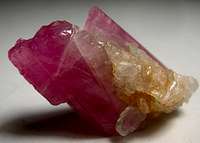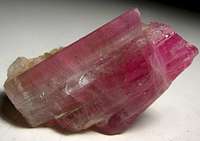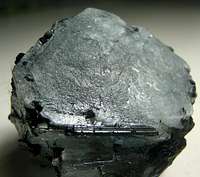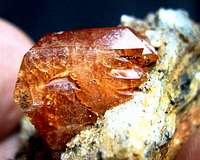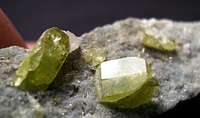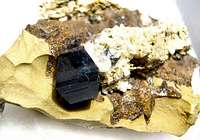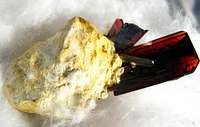Characteristics and classification
Gemstones are identified by gemologists, who describe gems and their characteristics using technical terminology specific to the field of gemology. The first characteristic a gemologist uses to identify a gemstone is its chemical composition. For example, diamonds are made of carbon (C) and rubies of aluminium oxide (Al2O3). Next, many gems are crystals which are classified by their crystal system such as cubic or trigonal or monoclinic. Another term used is habit, the form the gem is usually found in. For example diamonds, which have a cubic crystal system, are often found as octahedrons.
Gemstones are classified into different groups, species, and varieties. For example, ruby is the red variety of the species corundum, while any other color of corundum is considered sapphire. Emerald (green), aquamarine (blue), bixbite (red), goshenite (colorless), heliodor (yellow), and morganite (pink) are all varieties of the mineral species beryl.
Gems are characterized in terms of refractive index, dispersion, specific gravity, hardness, cleavage, fracture, and lustre. They may exhibit pleochroism or double refraction. They may have luminescence and a distinctive absorption spectrum.
Material or flaws within a stone may be present as inclusions.
Value of gemstones

There is no universally accepted grading system for any gemstone other than white (colorless) diamond. Diamonds are graded using a system developed by the Gemological Institute of America (GIA) in the early 1950s. Historically all gemstones were graded using the naked eye. The GIA system included a major innovation, the introduction of 10x magnification as the standard for grading clarity. Other gemstones are still graded using the naked eye (assuming 20/20 vision).[2]
For the past several hundred years, gemstones have been broken down into two categories; precious and semi-precious. Though today we think primarily of diamond, ruby, sapphire, and emerald as "precious", these categories are based mainly on fashion and the composition of these two lists has changed frequently over time.[3]
Recently a mnemonic device, the "four C's" (color, cut, clarity and carat), was introduced to help the consumer understand the factors used to grade a diamond.[4] With modification these categories can be useful in understanding the grading of all gemstones. The four criteria carry different weight depending upon whether they are applied to colored gemstones or to colorless diamond. In diamonds, cut is the primary determinant of value followed by clarity and color. Diamonds are meant to sparkle, to break down light into its constituent rainbow colors (dispersion) chop it up into bright little pieces (scintillation) and deliver it to the eye (brilliance). This is a function of cut. In its rough crystalline form, a diamond will do none of these things, it requires proper fashioning and this is called "cut". In gemstones that have color, including colored diamonds, it is the purity and beauty of that color that is the primary determinant of quality.
Physical characteristics that make a colored stone valuable are color, clarity to a lesser extent (emeralds will always have a number of inclusions), cut, unusual optical phenomena within the stone such as color zoning, and asteria (star effects). The Greeks for example greatly valued asteria in gemstones, which were regarded as a powerful love charm, and Helen of Troy was known to have worn star-corundum.[5]
A factor in determining the value of a gemstone is called water. Water is an archaic term that refers to the combination of color and transparency in gemstones; used hierarchically: first water (gem of the finest water), second water, third water, byewater.[6]
Historically gemstones were classified into precious stones and semi-precious stones. Because such a definition can change over time and vary with culture, it has always been a difficult matter to determine what constitutes precious stones.[7]
Aside from the diamond, the ruby, sapphire, emerald, pearl (strictly speaking not a gemstone) and opal [7] have also been considered to be precious. Up to the discoveries of bulk amethyst in Brazil in the 19th century, amethyst was considered a precious stone as well, going back to ancient Greece. Even in the last century certain stones such as aquamarine, peridot and cat's eye have been popular and hence been regarded as precious.
Nowadays such a distinction is no longer made by the trade. [6] Many gemstones are used in even the most expensive jewelry, depending on the brand name of the designer, fashion trends, market supply, treatments etc. Nevertheless, diamonds, rubies, sapphires and emeralds still have a reputation that exceeds those of other gemstones.
Rare or unusual gemstones, generally meant to include those gemstones which occur so infrequently in gem quality that they are scarcely known except to connoisseurs, include andalusite, axinite, cassiterite, clinohumite and bixbite.
y a fraction of the natural stones. Smaller synthetic diamonds have been manufactured in large quantities as industrial abrasives. Larger synthetic diamonds of gemstone quality, especially of the colored variety, are also manufactured.
Whether a gemstone is a natural stone or a lab-created (synthetic) stone, the characteristics of each are the same. Lab-created stones tend to have a more vivid color to them, as impurities are not present in a lab, so therefore do not affect the clarity or color of the stone. However, natural gemstones are still considered more valuable on average due to their relative scarcity.
The origin of the gemstone also does not affect its categorization as precious or semi-precious. Rubies, sapphires and emeralds are always precious stones, while other gems are considered semi-precious.
GEMSTONES AND CRYSTALS FROM JEWELS AND TOOLS
PLEASE VISIT OUR SISTER WEBSITES FOR MORE GEMSTONES AND CRYSTALS


Gemstones and Crystals at Jewels and Tools Amethyst Gemstones,Amber Gemstones,Carnelian Gemstones many more Gemstones to choose from. also Gemstone Cabochons and Gemstone Bead Strings. Many more to choose from.Jewellery Findings,Gold and Silver supplies Precious Metal Sales.All your Jewellery Making Tools and Supplies.Jewellery Making books and Equipment.
We are making an effort to present you with our entire spectrum of offers as soon as possible.For Jewellers tools.Jewelry Supplies Gemstones crystals and Beads you can visit us at our on line shops at
Gemstones & Crystals Gem Trees on Amethyst Base
email support@crystalcaves.co.uk
 FEDERATION OF SMALL BUSINES MEMBER
FEDERATION OF SMALL BUSINES MEMBER
We take telephone orders payment by WORLDPAY


Pakistan’s Gemstones: An Overview
Pakistan is home to many varieties of minerals, some of which make it prominent in the mineral world, such as peridot, aquamarine, topaz (various colours: violet and pink, golden and champagne), ruby, emerald, rare-earth minerals bastnaesite and xenotime, sphene, tourmaline, and many varieties and types of quartz.
 |
| Sphene. Northern Areas, Pakistan, 3.4 cm high. (Photo: Jeffrey Scovil; Gem: Bill Larson Collection) |
Pakistan shares a long and porous border (2430 km) with Afghanistan. This has effectively resulted in a full influx of all types of Afghan minerals into Pakistan, from which they are traded. Pakistan’s northwestern city of Peshawar serves as the first, direct, and only market for all minerals found in both these countries since 1979, after the Soviet Union invaded Afghanistan. Before the invasion, Pakistan’s only port city of Karachi held the bigger market of gem minerals (only facet rough and gems) in Pakistan. Following Peshawar’s rise in prominence, Karachi’s significance and role in gem minerals was reduced to those of little significance.
A Brief History of the Mining and Business of Gemstones in Pakistan
Pakistan came into existence in 1947 after partition of the subcontinent. A review of its history before the British rule reveals that its people and kings cherished gemstones highly. The relics of the Gandhara and Indus civilisations are a testimony to this fact. After its founding, Pakistan has given little, if not negligent, attention to this sector.
Gemstones Corporation of Pakistan was established in 1979 to effectively explore Pakistan’s own share of wealth in minerals and to facilitate gemstone mining and business in Pakistan. It had some valuable influence but ultimately was liquidated in 1997 and hence abandoned. There are two bodies now working for the welfare and growth of this industry in Pakistan: Trade Development Authority of Pakistan (formerly Export Promotion Bureau) and All Pakistan Commercial Exporters Association of Rough & Un-Polished Precious & Semi Precious Stones (APCEA). Since 1994, the annual Pakistan Gems and Mineral Show has been held in Peshawar with their joint collaboration, during four days in October. It has not as yet, however, attracted any potential buyers from abroad. Its few stalls on display cannot fulfill any of the requisite needs of experienced buyers from abroad, especially the USA and Europe.
 |
| Spessartine. Northern Areas, Pakistan, 5.0 cm high. (Photo: Jeffrey Scovil; Gem: Bill Larson Collection) |
The northern and northwestern parts of Pakistan are shrouded by the three world-famous ranges called Hindukush, Himalaya, and Karakorum. In these mountains have been found nearly all the minerals Pakistan currently offers to the world market, including aquamarine, topaz, peridot, ruby, emerald, amethyst, morganite, zoisite, spinel, sphene, and tourmaline.
The question arises as to how these were explored: by the very people living in and beside the hills and not as a result of any government involvement or support, a fact that the government of Pakistan cannot refute. In the industrial minerals sector, of course, the government-owned mining corporation is effective and has been of great help to local investors. Pakistan, through its one body, the Ministry of Petroleum and Natural Resources, has always recruited foreign investment in mining precious and semi-precious stones in Pakistan. But the rhetoric of the ministry is so inadequate and ineffective that no influential mining venture by any foreign institutes or individuals has taken place. One significant reason is the reputation for unreliability in the survey/analysis reports conducted by any government-sponsored institute in Pakistan.
Moving Forward
Pakistan must look into this situation very seriously. It can conduct such surveys by any reputable/foreign-based institutes to attract foreign investors in this sector. But the locals who have ever ventured into such activity have only stories of failure to tell.
In industrial mining, lease by provincial/local government exists, and in the case of precious/semi-precious stones it has been observed in emerald (Swat, Frontier Province), ruby (Pakistan’s Kashmir), and topaz (Katlung, Mardan District, Frontier Province), but has resulted in loss and/or failure for venturers.
 |
| Beryl: Northern Areas, Pakistan, 9.3 cm high. (Photo: Jeffrey Scovil; Gem: Bill Larson Collection) |
It is important to stress here that the non-professional residents of mining areas are actually the ones who mine these jewels of earth in their hazardous, traditional way of mining. They usually form groups that initiate diggings and blastings, distributing the costs that may incur during the mining period. This process is something that the Government of Pakistan has failed to control or investigate. The resulting product is compromised in terms of quality and quantity. Mining ventures in precious and semi-precious stones are uncontrollable in Pakistan because they are undertaken by its people without any permission, support, or guidance from the government.
Pakistan, based on its potential in mineral wealth, can become a great hub of the gemstone industry, on a scale comparable to that of Brazil, provided it takes a few essential, locally effective steps that can enhance the exploration of resources and growth of business. The most useful step: full and supportive involvement of the government with its own people as well as the foreigners involved in this industry. The establishment by Pakistan of the Gems and Gemmological Institute, in Peshawar in 2001, is an investment that ultimately will bear fruit.
Mining Areas
The few potential/major gemstone mining areas in Pakistan are: (only major gemstones yielded are mentioned)
Northwest Frontier Province
- Swat (Malakand division) – Emerald, various types of quartz, and epidote
- Dir (Malakand division) – Corundum and quartz
- Mansehra (Hazara division) – Corundum and smoky quartz
- Kohistan (Hazara division) – Peridot
- Peshawar district (Frontier province) – Quartz with astrophyllite/reibeckite fiber inclusions, xenotime, and bastnaesite
Federally Administered Tribal Areas
- Mohmand Agency – Emerald, clinozoisite, sphene, and epidote
- Bajaur Agency – Emerald, garnet, and orange-colour scapolite
- Khyber Agency – Quartz with astrophyllite/reibeckite fibers inclusions, xenotime, and bastnaesite
- North and South Waziristan Agencies – Faden quartz, diamond quartz, phantom quartz, chlorite-included quartz, and window quartz
Northern Areas
- Chilas (Diamer district) – Alluvial diopside, zircon, rutile quartz, aquamarine, and tourmaline
- Gilgi , Hunza, and Shigar (Gilgit district) – Aquamarine, topaz (golden and white), emerald (new find), ruby, pollucite, rutile quartz, morganite, apatite, spinel, and pargasite
- Shengus, Stak Nala, and Tormiq Nala (Baltistan Skardu Road, Baltistan district) – Aquamarine, topaz, tourmaline, apatite, sphene, morganite, and quartz
- Shigar Proper (near Skardu, Baltistan district) – Apatite, zoisite, rutile quartz, epidote, and morganite
- Childee, Kashmal, and Yuno (Shigar area, near Skardu, Baltistan district) – Aquamarine, emerald-colour tourmaline, apatite, morganite, topaz, and quartz
- Hyderabad, Testun, Dassu, Net Tahirabad, and Goyungo (Shigar area, Baltistan district) – Topaz (best golden colour here), aquamarine, tourmaline, morganite, rare earth minerals, apatite, quartz, and new find emerald
- Appu Aligund, Fuljo, Braldu, Bashu, and Karma (Baltistan district) – Tourmaline, aquamarine, garnets,diopside, ruby, pargasite, emerald, topaz, amethyst, scheelite, and quartz
- Khappalu and near Siachin area (Gaanshai area, Baltistan district) – Aquamarine, amethyst, and fine golden rutile quartz
Baluchistan Province
- Kharan district – Brookite, anatase, and quartz
- Chaman (near Quetta) – Diamond quartz, window quartz, quartz on prehnite-base, and faden quartz included by chlorite
called Hindukush, Himalaya, and Karakoram. In these mountains have found nearly all the minerals, including aquamarine, topaz, peridot, ruby, emerald, amethyst, morganite, zoisite, spinel, sphene, and tourmaline.
Major Gemstone Mining Areas in Pakistan.
Northwest Frontier Province
Swat (Malakand division) – Emerald, various types of quartz, and epidote
Dir (Malakand division) – Corundum and quartz
Mansehra (Hazara division) – Corundum and smoky quartz
Kohistan (Hazara division) – Peridot
Peshawar district (Frontier province) – Quartz with astrophyllite/reibeckite fiber inclusions, xenotime, and bastnaesite
Federally Administered Tribal Areas
Mohmand Agency – Emerald, clinozoisite, sphene, and epidote
Bajaur Agency – Emerald, garnet, and orange-colour scapolite
Khyber Agency – Quartz with astrophyllite/reibeckite fibers inclusions, xenotime, and bastnaesite
North and South Waziristan Agencies – Faden quartz, diamond quartz, phantom quartz, chlorite-included quartz, and window quartz
Northern Areas of Pakistan
Chilas (Diamer district) – Alluvial diopside, zircon, rutile quartz, aquamarine, and tourmaline
Gilgit,Hunza , Aquamarine, topaz (golden and white), emerald (new find), ruby, pollucite, rutile quartz, morganite, apatite, spinel, and pargasite
Baltistan,Skardu, Shigar,Shengus,Stak Nala and Tormiq Nala Aquamarine, topaz, tourmaline, apatite, sphene, morganite, and quartz
Shigar Baltistan district – Apatite, zoisite, rutile quartz, epidote, and morganite
Childee, Kashmal, and Yuno (Shigar area, near Skardu, Baltistan district) –Aquamarine, emerald-colour tourmaline, apatite, morganite, topaz, and quartz
Hyderabad, Testun, Dassu, Net Tahirabad, and Goyungo (Shigar area, Baltistan district) – Topaz (best golden colour here), aquamarine, tourmaline, morganite, rare earth minerals, apatite, quartz, and new find emerald
Appu Aligund, Fuljo, Braldu, Bashu, and Karma (Baltistan district) – Tourmaline, aquamarine, garnets,diopside, ruby, pargasite, emerald, topaz, amethyst, scheelite, and quartz
Khaplu ,Saltoro near Siachan Glacier area (Gaanshai area, Baltistan district) – Aquamarine, amethyst, and fine golden rutile quartz
Baluchistan Province
Kharan district – Brookite, anatase, and quartz
Chaman (near Quetta) – Diamond quartz, window quartz, quartz on prehnite-base, and faden quartz included by chlorite
Images
|
|
| ||||||
|
|
| ||||||
|
|
| ||||||
|
|
| ||||||
|
|
|
Buying Gemstones in Afghanistan?

OK, I am getting a lot of emails (100's) from mostly military people that are stationed in Afghanistan or at least in the general region.
So I am going to write this article as a thank you and hopefully to help people over there out.
First here is some advice that I know most people will probably not listen too. But...
If you are buying gemstones anywhere (Africa, Afghanistan, Pakistan, where ever...) and have no experience with the business of gemstones. As the saying goes... " There is a sucker born every minute." Keep it in mind.
There are all types of scams and scammers in gemstones, especially around the mines where they are found in ANY country. There are usually more scams around the mine than any where else. However that does not mean you cannot be cheated in a well known store or trading area. Buying and selling Gem stones is an "everything goes" type of business. So be aware of what you are getting into and realize that there is a lot of things going on you may not know about.
Remember that... "No, in most cases the miner or seller is NOT your best buddy." If you remember anything, remember that to most of these people (in 3rd world countries, but every where in the gem stones business) you are an (often a rich) out sider to them, their c
uamarine, and with the deposits of emerald and kunzite. Each gemstone is discussed with its legends and lore, locations and geology, methods of mining and productions, and a concise description of physical properties. A closing chapter provides a short summary of Afghanistan's mineral deposits and economic development potential. Appendixes furnish the geographic coordinates of Afghan mineral occurrences, the properties of gemstones, and a glossary of gemological terms. Chapter-end references and suggested readings. A topically and geographically specialized book recommended for libraries maintaining a reference section on gemstones and gem collecting. --ChoiceEarth, August, 1996 This unusual book on the gems of Afghanistan is part of a series by Geoscience Press on the world's gemstone-producing region....Authors Bowersox and Chamberlin provide ample information about the science and technology behind producing gems in Afghanistan. But they also lace the book with lore from ancient writers and punctuate the text with many personal observations based on two decades of traveling to the area and working with Afghan gemstones. ...Interested travelers to the region will appreciate the location of the hundreds of mines pinpointed with Global Position System satellite readings. More casual rockhounds will admire this comprehensive book on the geology, history, and lore of the gems in Afghanistan. --Earth
In their handsome and richly illustrated volume directed to gemologists and serious gem collectors, Bowersox and Chamberlin explore the beauty and history of Afghanistan's gemstones, and describe mines, deposits, and occurrences. The authors, professional gem hunters with expensive experience in Afghanistan, write very well in a lively style that blends factual objectivity with appropriate personal narrative. The text opens with geographic and geological perspective and a related historical sketch of Afghanistan. The heart of the book deals with lapis lazuli, the most widely prized of Afghan gems, with Afghan varieties of ruby, sapphire, tourmaline, and aquamarine, and with the deposits of emerald and kunzite. Each gemstone is discussed with its legends and lore, locations and geology, methods of mining and productions, and a concise description of physical properties. A closing chapter provides a short summary of Afghanistan's mineral deposits and economic development potential. Appendixes furnish the geographic coordinates of Afghan mineral occurrences, the properties of gemstones, and a glossary of gemological terms. Chapter-end references and suggested readings. A topically and geographically specialized book recommended for libraries maintaining a reference section on gemstones and gem collecting. -- Choice, May, 1996
Mineral News, March, 1996 This is the first comprehensive book on the geology, history, and lore of the gemstones and gem deposits of Afghanistan. This book is well documented and the reference list of each chapter is extensive. Although, most of these references are on the history and geography of Afghanistan, there are many references on the geology and gemstones. The authors have been associated with Afghanistan gemstones and mining for many years. They have worked with three Afghan governments, the Soviets, and the Afghan miners developing the gem deposits. This book takes the reader through the history of Afghanistan, to the recent war with the Soviets into the present times. The Geology is explained with information on the region and descriptions of each deposit. The discovery of each deposit is discussed as well as the present situation and mining. ....Naturally this book's emphasis is on gem materials, but there is much here for the mineral collector too. Obviously, most gem deposits also produce specimens suitable for any mineral collection and many of the deposits described have produced specimens that make it to the mineral market and not the gem cutting tables around the world. Although the geology descriptions are sometimes brief, Gemstones of Afghanistan is a good source of information on the mines, mining methods, geology, and minerals/gem materials Afghanistan produces. --Mineral News
This is the first comprehensive book on the geology, history, and lore of the gemstones and gem deposits of Afghanistan. This book is well documented and the reference list of each chapter is extensive. Although, most of these references are on the history and geography of Afghanistan, there are many references on the geology and gemstones.
The authors have been associated with Afghanistan gemstones and mining for many years. They have worked with three Afghan governments, the Soviets, and the Afghan miners developing the gem deposits.
This book takes the reader through the history of Afghanistan, to the recent war with the Soviets into the present times. The Geology is explained with information on the region and descriptions of each deposit. The discovery of each deposit is discussed as well as the present situation and mining. ....Naturally this book's emphasis is on gem materials, but there is much here for the mineral collector too. Obviously, most gem deposits also produce specimens suitable for any mineral collection and many of the deposits described have produced specimens that make it to the mineral market and not the gem cutting tables around the world.
Although the geology descriptions are sometimes brief, Gemstones of Afghanistan is a good source of information on the mines, mining methods, geology, and minerals/gem materials Afghanistan produces. -- Mineral News, March, 1996
This unusual book on the gems of Afghanistan is part of a series by Geoscience Press on the world's gemstone-producing region....Authors Bowersox and Chamberlin provide ample information about the science and technology behind producing gems in Afghanistan. But they also lace the book with lore from ancient writers and punctuate the text with many personal observations based on two decades of traveling to the area and working with Afghan gemstones.
Product Description
GEMSTONES OF AFGHANISTAN is the first comprehensive, fully-documented book on the geology, history, and lore of the gems and minerals of this war-ravaged crossroads between the Near East and the Far East. GEMSTONES OF AFGHANISTAN features stunning color photographs, original maps, and geographic coordinates of significant mines. The authors have compiled a wide-ranging and thorough set of references that, like the book, will prove invaluable to jewelers, gem buyers, geologists, historians, and those who seek to make a careful assessment of the riches Afghanistan has to offer. GEMSTONES OF AFGHANISTAN is the first complete reference on gemstones of Afghanistan - the results of 23 years of researching over 6,500 years of history. o Hardcover, glossy 81/2" x 11", 244-page collection edition o 110 photographs, maps and figures, including 52 in color o History of geology and gem mining in Afghanistan, describing mining methods and production o Detailed topographical and geological maps pinpoint gem and mineral deposits o Over 1,400 gem and mineral locations by coordinates o 2,000 years of geological, geographical and gemological exploration o Over 500 references and suggested readings o Color photographs of new cutting styles, carved gems and new jewelry designs
Afghanistan: Panjshir Valley Emeralds & Jegdalek Ruby
Gemstones of Afghanistan
Afghanistan, formerly known as Nuristan, or the "Land of Light," has stood at the crossroads of ancient Indian, Persian, European, and Asian civilizations for thousands of years. The remote and inhospitable land of the Pashtun people lies along the silk and gem caravan trade routes, making it the gateway for conquests from Alexander the Great and the Moguls of India, to the Soviet Union and Taliban of recent history.
Afghanistan's rugged Hindu Kush mountain range, and the region's fierce Chitral, or Nuristani Kafir indigenous inhabitants have made this foreboding land both a natural fortress, and a treasure-trove of under-exploited mineral wealth. A wide range of precious gemstones are found in Afghanistan, such as aquamarine, emerald, garnet, kunzite, lapis lazuli, ruby, sapphire, tourmaline, turquoise, and zircon.
 | |  Panjsher Valley (Photo: Wiki Public Domain) |
Due to its proximity to major east-west trading routes, Afghanistan was the beneficiary of artistic influences from around the ancient world. No where was this more evident than at the excavated tombs of Ai Khanum (aka Ai Khanoum, Alexandria on Oxus), Bactria, Begram, and Tillya Tepe (aka Tillia Tappeh or "hill of gold"), where ornamental jewelry was festooned with exotic materials from distant lands (amber, carnelian, ivory, pearls, and mother-of-pearl), and decorated with motifs from China, Greece, Egypt, Persia, Siberia, and Rome.
Lapis Mining in Afghanistan
Gemstone mining in Afghanistan dates back some 6,500 years, to the gem mines of Badakhshan (Badakshan, Badahsan) Province and Panjshir (Bactria) valley. One of the first gems to be extracted from this region was lapis lazuli, from the mines at Sar-e-Sang (Sare Sang) located in the Kokcha Valley of north-eastern Afghanistan.
Emerald Mining in Afghanistan
Most of the emerald mines in Afghanistan today are small-scale operations with the oldest being the Buzmal Mine in Bismal-Riwat. Afghan Emerald is mined at an elevation of 3,000 to 4,000 meters, in the Panjsher Valley (Panjshir, Panshir, Panshjer) which extends through the Kapisa, Parvan, and Panjshir province, north-east of the capital city of Kabul. Other mining areas in the Panjsher region are at Mukeni-Zara Kel, and Ringe. Emerald is also mined in neighboring Pakistan, at the Gujar Killi emerald deposit, in the Northwest Frontier Province.
 Nuristan (Photo: Wiki Public Domain) | |  Kafir Tribesmen c. 1920 (Photo: Wiki Public Domain) |
Afghan emerald is found in gabbro rock formations within quartz-ankerite veins. Afghan emeralds tend to be more transparent and somewhat brighter than Columbian emeralds, with a pale green interior and a darker green exterior [2].
Panshjer Valley emeralds have distinct multiphase tabular inclusions that run parallel or perpendicular to the c-axis, as well as subhedral equant inclusions that occur in conjunction with the tabular inclusions.
Ruby & Sapphire Mining in Afghanistan
Sapphire and ruby mining in Afghanistan has taken place at the Jegdalek mines for over seven hundred years. The Jegdalek-Gandamak mines are located in a remote and inaccessible region some 100 kilometers east of Kabul, and south of Jalalabad, in Kabul province. 75% of the production at the Jegdalek mines is in the form of pink to violet-pink sapphire, with rubies accounting for 15%, and the balance being blue sapphire [4].
Ruby form the 'Jegdalek ruby deposit' occurs within host gneiss and/or marble, can be near-colorless to pure red or purplish-red, exhibiting strong fluorescence. Some of the highest quality stones mined at Jegdalek are comparable to those of Mogok in Myanmar.
The Jegdalek mining region is situated along a continental collision-zone that is sandwiched between the Asian and Indian tectonic plates which create three distinct tectonic terrains: the southern (Gondwanic), central (Tethyan), and northern (Eurasian) zones. The Jegdalek deposits occur within metamorphosed limestones that were originally deposited in ancient seas along the edge of the continental plates.[5]. Much of this remote region's gem production is transported through the Khyber Pass to dealers in Peshwar, Pakistan.Astrology : Astro Stones
Gems have been in use since time immemorial and are worn by people of both sexes in various forms as rings, pendants, bracelets, etc. to ward off the evil effects of planets and to enhance the benefits of certain beneficial planets and also to add the wearer's beauty and personality. In the ancient times, rings were worn on the index finger to convey to others that the person was interested in marriage; on the middle finger, it was meant to indicate that he was already engaged; on the ring finger, it denoted that he was already married and if some one decided to remain single, he would wear a ring on the little finger. The little finger is associated with family attachments and strong and positive family influences on the wearer of the ring.
The Power of Gems:
Gems have enormous power as far as astrology is concerned. From very ancient times it is believed that Gems have curative as well as other powers, which influence an individual according to his zodiac for better or for the worse. Gems if chosen properly, is said to change the stars for the betterment of one’s future and if they are not suited to a person their effect can be adverse. Hence, if one chooses to wear a gem for one’s betterment, he should be very careful before using it. At Work: A Gem suited to an individual is capable of bringing out the best in him or her. One’s positive qualities get highlighted and they are capable of growing stronger if on wearing the right gem. One’s weak areas are also benefited through gems. Much work comes out to be fruitful and one can reach tremendous heights of achievement satisfaction in work place. Promotions that were held up due to an assortment of factors can soon move towards a favorable outcome.
At Home: Wearing a Gem is capable of influencing the home front. Be it some problem surfacing the marital front or problems with property, wearing the right kind of gem is said to be capable of giving positive results for any problems. Any problem with the family is taken care of with the help of an appropriate gem.
Love & Romance: The effect of the right kind of gem can have a phenomenal impact on one’s love life. If one is waiting for somebody to come closer in love or matrimony, a Gem can accentuate the time and help bring it nearer. If romance in one’s life begins to shadow, a gem could do wonders. A gem can ensure that alliances riddled by uncertainties become more solid, and it helps add a special lustre to stable relationships.
At Business: Business can prosper and finances can soar skywards at a rapid pace if one wears the right gem. Opportunities to improve on business and financial prospects can become abundant through an unexpected chain of events. Market conditions can tend to be favourable and the financial grapevine can provide one with excellent tips.
Health: The wearing of the right kind of Gem leads one to avoid various health problems. If one desires a slimmer figure, greater resistance to infections and a good health, it’s better to go for the right kind of gem.
